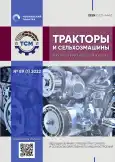Method for analyzing parameters of single-level pneumatic elastic elements with backpressure
- Authors: Nakaznoy O.A.1, Tsipilev A.A.1
-
Affiliations:
- Bauman Moscow State Technical University (National Research University)
- Issue: Vol 89, No 1 (2022)
- Pages: 23-30
- Section: New machines and equipment
- URL: https://journals.rcsi.science/0321-4443/article/view/99890
- DOI: https://doi.org/10.17816/0321-4443-99890
- ID: 99890
Cite item
Full Text
Abstract
BACKGROUND: Trucks, as a rule, have a significate difference between the kerb and gross weights. Usual spring or leaf suspensions do not allow to have acceptable values of static running and suspension stiffness at different machine loading, and pneumatic elastic elements, despite their relative simplicity, are mainly implemented only on overseas technology samples, and designers do not pay attention to pneumatic elastic elements with counterpressure. One of determinants of truck users is the acceptable vibration loading of the driver’s seat. Trucks with a carrying capacity comparable or even overestimated to their kerb weight, when they move without cargo on public roads, especially with a dirt surface, have significant levels of vibration acceleration at using the metal elastic.
AIMS: The purpose of the present work is to reduce the vibration loading of the driver’s seat due to rational choice of parameters of the cushioning system with pneumatic elastic elements with backpressure, that ensures the non-zero static travel and saticfactory stiffness of suspension in the kerb and loaded state.
METHODS: Using the regorous mathematical tools of Mechanics, Pneumatics and Thermodinamics, scientific-based theoretical prerequisites as well confirm the validity and reliability of the presented dependencies for characteristics calculation, conclusions and recommendations.
RESULTS: According to the method developed and proposed in this article, effective characteristics of the pneumatic elastic elements with a single-level stiffness and backpressure for a KAMAZ-53215 Selkhoznik truck were obtained. At the kerb weight, the static stroke of the front and rear suspensions is approximately 0.06 m; at a gross weight it is of 0.12 m and 0.24 m, respectively. The period of normal vertical vibrations decrease by 25% versus a gross vehicle weight and by 31% at absence of backpressure, however, it occurs in the allowable range.
CONCLUSIONS: The proposed method allows to determine the base design parameters of the pneumatic elasticity of the suspension elements of wheeled vehicles, providing an acceptable periods for a normal vertical oscillations of the cushoining body with maintaining the non-zero static stroke to a large weight range.
Full Text
##article.viewOnOriginalSite##About the authors
Oleg A. Nakaznoy
Bauman Moscow State Technical University (National Research University)
Email: nakaznoi@gmail.com
ORCID iD: 0000-0003-4029-2434
SPIN-code: 9767-0435
Doctor of Sciences in Engineering, Professor
Russian Federation, MoscowAlexander A. Tsipilev
Bauman Moscow State Technical University (National Research University)
Author for correspondence.
Email: alexts@bmstu.ru
ORCID iD: 0000-0002-5764-0506
SPIN-code: 3877-2736
Candidate of Sciences in Engineering, Assistant Professor
Russian Federation, 5 build. 1, Lefortovskaya Naberezhnaya, Moscow, 105005References
- Kotiev GO, Smirnov AA, Shilkin VP. Issledovanie rabochikh protsessov v pnevmogidravlicheskikh ustroistvakh sistem podressorivaniya gusenichnykh mashin: ucheb. posobie. Moscow; Izd-vo MGTU im. N.E. Baumana; 2001. (In Russ).
- Kotiev GO. Kompleksnoe podressorivanie vysokopodvizhnykh dvukhzvennykh gusenichnykh mashin. Moscow; MGTU im. N.E. Baumana; 2010. (In Russ).
- Sarach EB, Kotiev GO, Smirnov IA. Development prospects of the suspension system for high-speed tracked vehicles. Engineering journal: science and innovation. (10):48. Available from: http://engjournal.ru/catalog/machin/transport/976.html. (In Russ).
- Zhileikin MM, Kotiev GO, Sarach EB. Eksperimental'noe issledovanie nagruzochnykh kharakteristik dvukhkamernoi pnevmogidravlicheskoi ressory podveski avtomobil'nykh platform novogo pokoleniya srednei i bol'shoi gruzopod"emnosti. Nauka i obrazovanie: nauchnoe izdanie MGTU im. N.E. Baumana. 2011;(10):77. Available from: http://technomag.bmstu.ru/doc/346642.html. (In Russ).
- Zhileikin MM, Kotiev GO, Sarach EB. Metodika podbora kharakteristik upravlyaemoi podveski s dvumya urovnyami dempfirovaniya mnogoosnykh kolesnykh mashin. Nauka i obrazovanie: nauchnoe izdanie MGTU im. N.E. Baumana. 2011;(2):15. Available from: http://technomag.bmstu.ru/doc/293578.html. (In Russ).
- Zhileikin MM, Kotiev GO, Sarach EB. Metodika rascheta kharakteristik pnevmogidravlicheskoi upravlyaemoi podveski s dvukhurovnevym dempfirovaniem mnogoosnykh kolesnykh mashin. Nauka i obrazovanie: nauchnoe izdanie MGTU im. N.E. Baumana. 2011;(1):45. Available from: http://technomag.bmstu.ru/doc/346660.html. (In Russ).
- Kotiev GO. Prognozirovanie eksplutatsionnykh svoistv sistem podressorivaniya voennykh gusenichnykh mashin. [dissertation]. Moscow; MGTU; 2000. (In Russ).
- Sarach EB. Metod vybora kharakteristik sistemy podressorivaniya s netselym chislom stepenei svobody dlya bystrokhodnoi gusenichnoi mashiny. [dissertation]. Moscow; MGTU; 2003. (In Russ).
- Smirnov AA. Matematicheskoe modelirovanie pnevmogidravlicheskikh ustroistv sistem podressorivaniya transportnykh sredstv. [dissertation]. Moscow; MGTU; 1999. (In Russ).
- Sukhorukov AV. Upravlenie dempfiruyushchimi elementami v sisteme podressorivaniya bystrokhodnoi gusenichnoi mashiny. [dissertation]. Moscow; 2003. (In Russ).
- Tsipilev AA. Metody opredeleniya raschetnykh kharakteristik i otsenki teplovoi nagruzhennosti pnevmogidravlicheskikh ustroistv sistem podressorivaniya bystrokhodnykh gusenichnykh mashin na etape proektirovaniya. [dissertation]. Moscow; MGTU im. N.E. Baumana; 2017. (In Russ).
- Sarach EB, Tsipilev AA. Osnovy raschetov pnevmogidravlicheskikh sistem podressorivaniya. Uchebnoe posobie. Moscow: Izdatel'stvo MGTU im. N.E. Baumana; 2017. (In Russ).
- Tsipilev AA. Osnovy raschetov pnevmogidravlicheskikh sistem podressorivaniya. Uchebno-metodicheskoe posobie. Moscow: Izdatel'stvo MGTU im. N.E. Baumana; 2020. (In Russ).
Supplementary files











